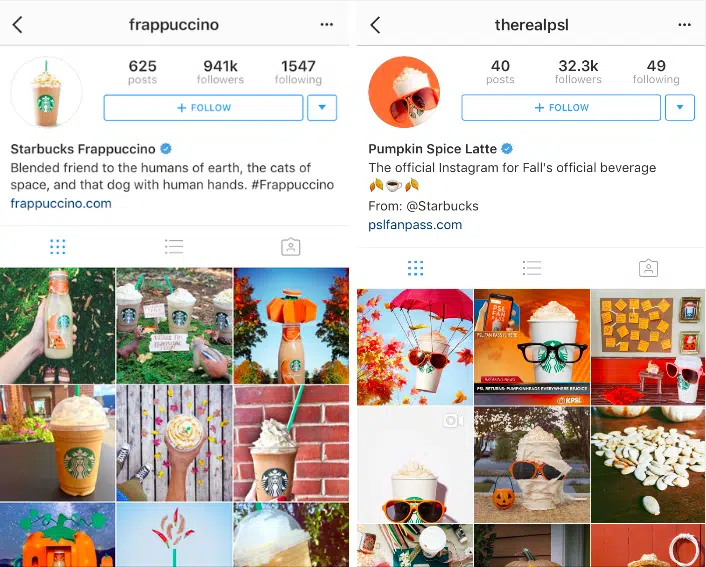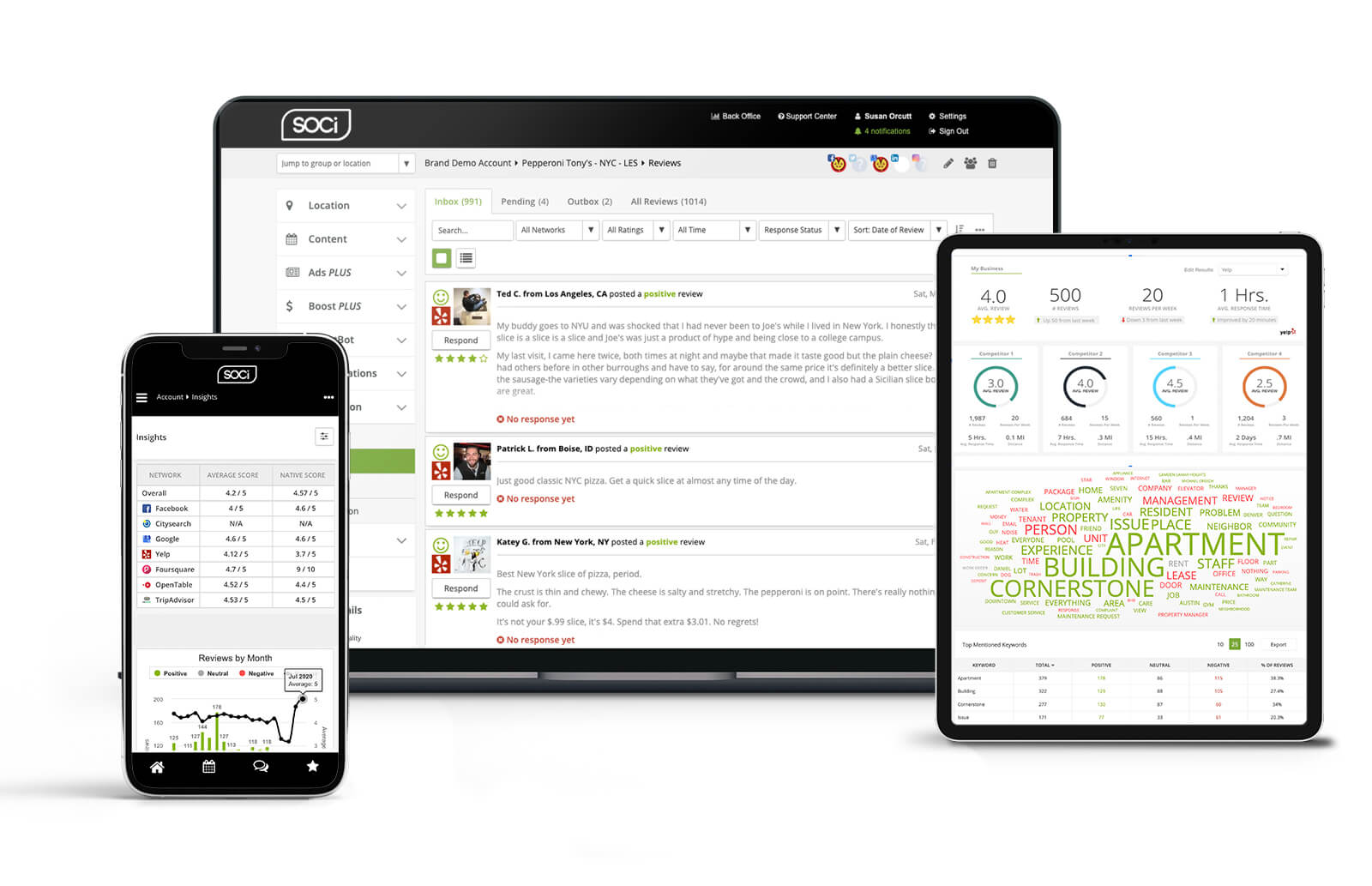How to Have the Best-In-Class Brand Reputation Management
Table of Contents
Your brand’s reputation influences everything from customer loyalty to thought leadership in your space and your market share. In today’s digital world, you need a strong brand reputation management strategy to address customer concerns wherever they take place.
At SOCi, we’ve helped over 600 multi-location businesses, and over three million individual locations manage their brand’s online reputation. In this blog, we’ll discuss everything you need to know about brand reputation management from the lessons we’ve learned.
What is Brand Reputation Management?
Brand reputation management is the constant action of monitoring how the public perceives your brand and having a strategic system in place to boost your brand’s image.
When your brand’s reputation takes a hit, your marketing, sales, customer service efforts, and nearly everything in-between becomes more challenging. With a strong brand reputation management system in place, you can get ahead of possible PR crises and prevent minor issues from arising over time that dilute your brand’s reputation.
Your brand’s reputation can be impacted by:
- Social media
- Review sites
- Performance of local business locations
- Customer service or support efforts
- Sales calls or interactions
As you can see, brand reputation management touches nearly every aspect of your business. To help you correctly manage your brand’s reputation, we’ve listed five actionable strategies your multi-location business can begin to implement today.
The 5 Most Important Brand Reputation Management Strategies
1. Improve Brand Association Through Social Media
Brand association is a connection someone makes between your brand and a concept, image, emotion, experience, person, interest, or activity. For current and previous customers, this association depends heavily on how previous interactions went with your company and their overall customer experience.
The type of content you organically produce or advertise on social media and other online channels can help you somewhat control and improve brand association.
For example, Starbucks’ social media uses a mixture of creative captions and human connections to entice social media users and create a more humanized connection. Even their products, which have their own personalities, build a sense of community and pique consumers’ interest.
To best understand how your social media content is performing, you need to monitor and measure public sentiment around your organic and paid social posts.
We recommend measuring the number of engagements (likes, shares, comments, etc.) your posts receive and replicate successful content. It’s also essential to be aware of negative feedback and when content misses the mark or receives an unfavorable reaction. Doing so will help your brand avoid negative brand association.
To further improve brand association, multi-location businesses should also consider posting localized social content. Previous research revealed that localized content receives 12x more engagement than general or non-localized content. If you need help planning your localized social content strategy, read our Localized Social Content Guide for best practices and examples of multi-location businesses creating killer localized social content.
Key takeaway: Create engaging and humanizing social media content, and have tools to measure public sentiment and performance.
2. Implement a Social Listening Strategy
Social listening is the continual act of analyzing online conversations and trends about your brand, competitors, and industry. Social listening occurs on social media platforms, local business pages, Google Business Profiles (GBPs), and review sites. Below, we dive into three ways social listening can help your brand’s reputation.
Respond to Customer Engagements
Without social listening, your multi-location business will find it challenging to identify and address the conversations about your business and respond accordingly. As you can imagine, this will begin to negatively impact your brand’s reputation.
With social listening, you can proactively engage with consumers. For instance, if an unsatisfied customer leaves a negative review or complaint on social about one of your business locations, you need to respond to that customer ASAP — ideally under 48 hours. In fact, 87 percent of consumers have expressed a willingness to change a negative review depending on how the company responds.
Social listening allows you to catch any potential problems before they exacerbate. On the flip side, if you receive positive customer feedback, you want to share that with other potential customers. In this case, social listening can provide you with user-generated content (UGC), which can help you fuel your content strategy.
Score Competitive Insight to Drive Your Campaigns
Social listening also allows your brand to follow your competitors and, more specifically, keep an eye on what consumers say about them. If done correctly, your social listening and customer advocacy programs will reveal insight into the main differentiators between your business and your top competitors.
For instance, let’s say a competitor releases a new product, and it’s an absolute hit with their target audiences. You can use that information to adjust your product(s) accordingly. Or vice versa, if a competitor’s product flops, you can communicate these shortcomings to consumers in your marketing and sales process and highlight how your product differs.
Gain Industry Knowledge
Another benefit of social listening is acquiring industry knowledge directly from consumers. With a robust social listening program, you can act as a fly on the wall and gain insight into your industry’s most recent changes, challenges, and general public sentiment.
With this industry knowledge, you can produce reports, studies, and social posts on current trends at the local and national level. This thought-leadership content often improves your share of voice and reputation.
Key takeaway: Create a social listening strategy with the right tools to better understand your and your competitors’ target audiences and industry changes. Use that information to drive your sales and marketing strategies.
3. Offer a Great Customer Experience
Customer experience (CX) is how customers perceive and feel about your company and brand throughout the relationship with your business. Every interaction with a customer affects your CX, which then impacts your brand’s reputation. Thus, it’s imperative to have a strong CX marketing program. Below are three CX strategies that’ll help improve your brand’s reputation.
Consistent messaging
Ensure that you have standardized branding and messaging guidelines for marketing, sales, and customer service departments. These guidelines will help to ensure that no matter who a customer interacts with, the messaging is the same. Customers expect and enjoy consistent messaging whenever they interact with your company — regardless if it’s on a sales or service call or reading a newsletter or blog post.
Conduct customer surveys
Customer surveys reveal customers’ pain points or issues that they might not have openly stated unless prompted. Reaching out to customers also makes them feel cared for, which improves their sentiment towards your business. While conducting surveys is helpful, your business must follow through and optimize the pain points found in the survey results.
For a list of the best survey questions to send customers, read our article on customer advocacy KPIs (key performance indicators).
Stay in touch with your customers
It’s also important to keep in touch with your customers beyond sending surveys. Your brand can send customers useful information such as industry reports, data studies, helpful guides, new product launches, discount codes, etc. This type of information keeps customers in the loop and reminds them that you’re a thought leader in the space, helping to improve your overall reputation.
Key takeaways: A strong CX program keeps customers satisfied and provides a wealth of customer feedback that you can re-purpose in your brand messaging.
4. Manage And Respond to Reviews
As we mentioned earlier, managing review response is critical to your CX and brand reputation management programs. These statistics speak for themselves:
- Ninety-seven percent of consumers who read a business’s reviews pay attention to the business’s response.
- Forty percent of consumers expect a response to their negative reviews within 24 hours of posting them.
Therefore, you need a review response system in place to answer both positive and negative reviews. For multi-location businesses, deciding if a corporate team, local store managers, or a mixture of the two will respond to reviews is critical. Regardless of which system you choose, make sure each team and its members have the proper training and are responding to the reviews in a personalized and timely manner.
For an in-depth discussion of how to respond to reviews, read our Multi-Location Marketer’s Guide to Online Reputation Management.
Having the right software in place is another critical element of review response. SOCi Reviews allows both corporate and local teams to respond to reviews across all significant reputation and review networks.
You can also leverage critical insights and patterns from reviews to help make better business decisions. Responding to reviews and leveraging data from reviews improves your brand’s local reputation and makes it easier to manage.
Key takeaways: Create a review response system that can sustainably respond to all review types genuinely and authentically.
5. Address Crises Head-on
An unforeseen event resulting in a crisis is often a company’s worst nightmare, but they do happen from time to time. So, it’s essential to have a crisis plan in place.
Crises come in many forms. For instance, the COVID-19 pandemic was a global crisis that made many companies redesign their entire operations and workflow. Internal crises also occur when a product or advertising campaign fails, or troublesome information becomes common knowledge.
Regardless of the crisis, it’s best to address it head-on so a ripple effect doesn’t occur, further dampening your brand’s reputation. Take the following steps to address a crisis adequately:
- Have a designated team in place
- Be proactive by apologizing early on (if the issue(s) was preventable) to the affected parties
- Monitor the situation and address issues accordingly
- Track sentiment analysis
- Review and learn from the crisis
Key takeaways: Take swift action by having a designated team in place and monitor the situation and public sentiment throughout the crisis and afterward.
Using the Right Tools
Now that you have the information needed to improve your brand’s reputation management efforts, it’s time to get started. As mentioned, SOCi has various tools to help you develop a best-in-class reputation.
To recap, our social media management software can help you deploy localized content across all of your business locations, improving brand association. In addition, SOCi Reviews can help you track and respond to reviews on all major review sites.
To learn information about any of these products or more about SOCi’s services, request a demo today!




